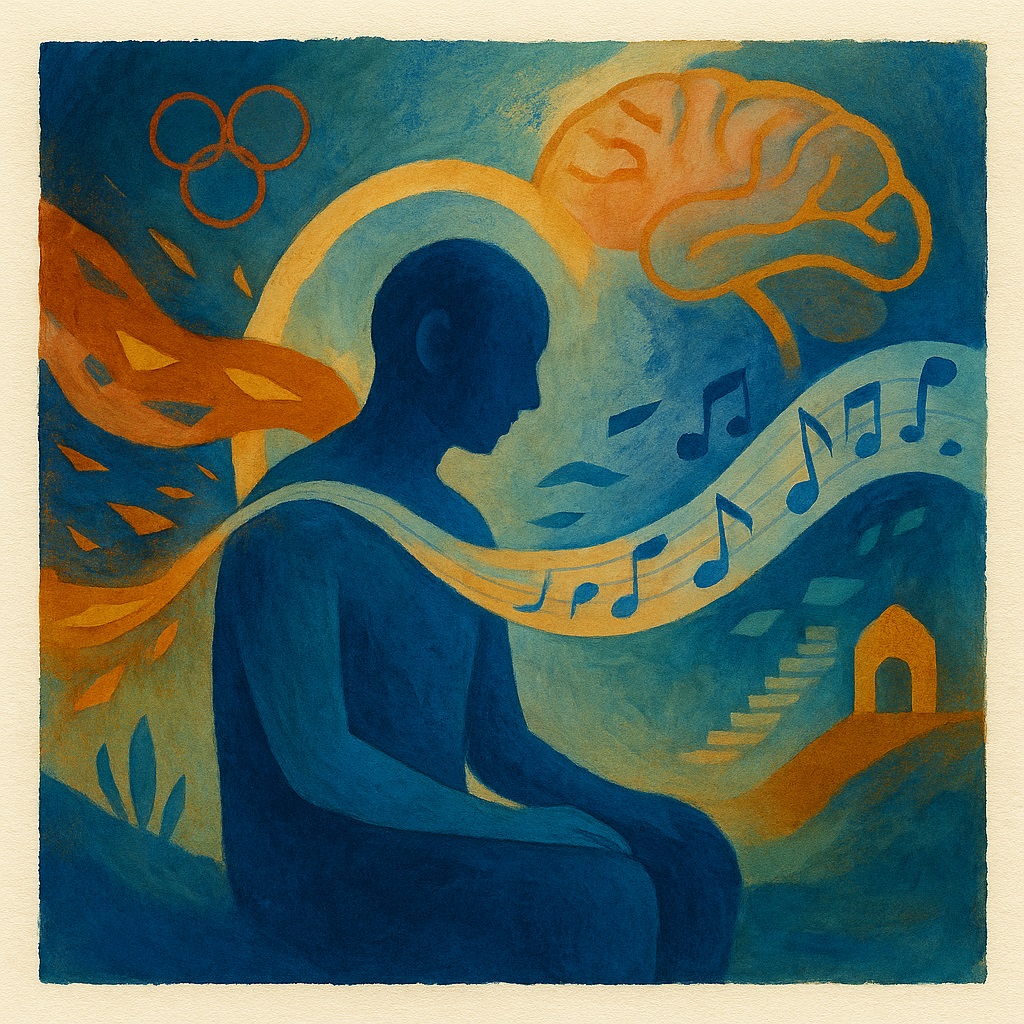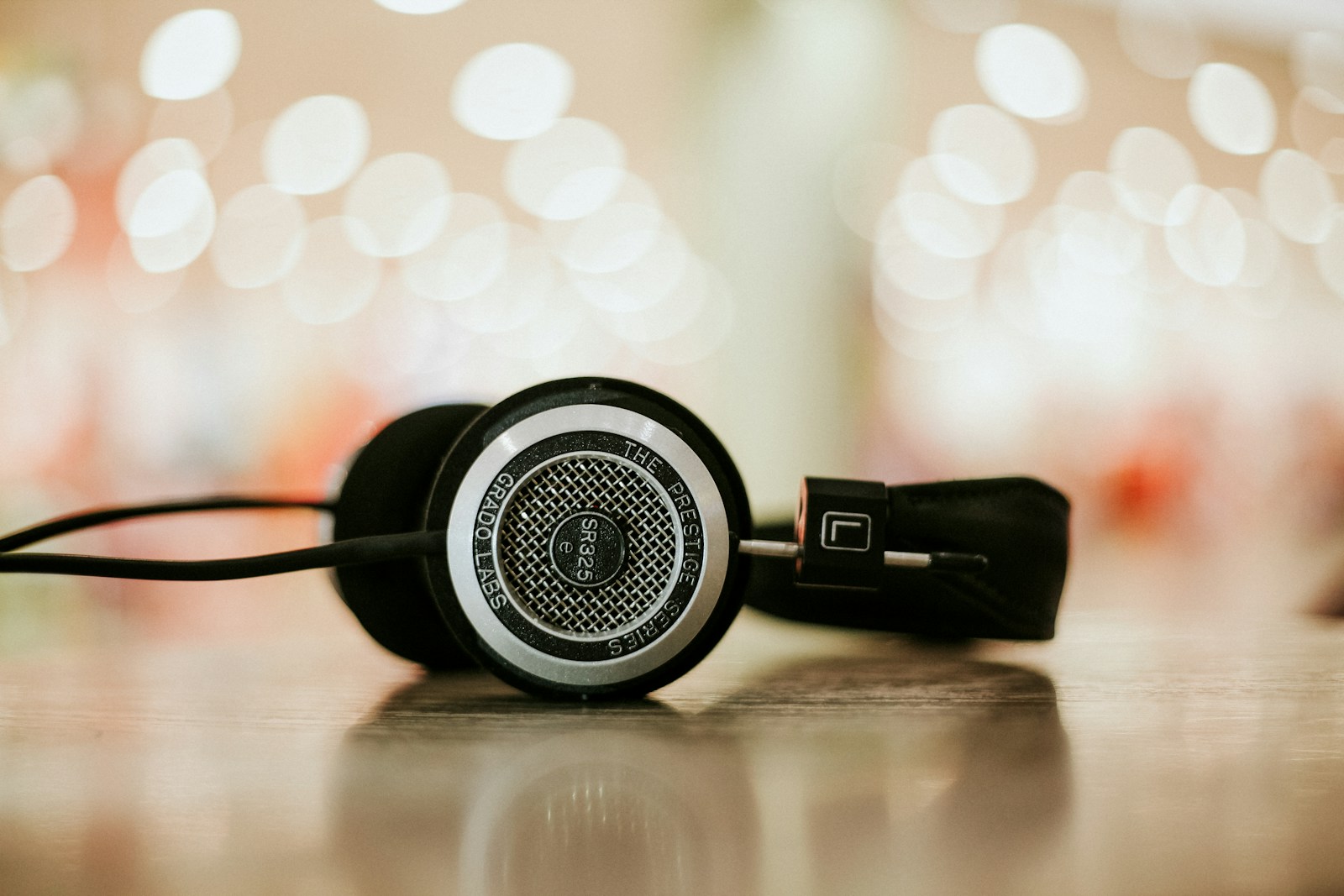Music is more than entertainment. In clinical and non-clinical work with anxiety, obsessive-compulsive, trauma- and stressor-related, and somatic symptom disorders, it serves as a useful, well-controlled adjunct to psychotherapy and, where indicated, medication. It acts in parallel on affect, attention, physiological regulation, and social engagement.
My essay brings the current case together and sets it up for practice—from the rationale and mechanisms of action, through the selection of key parameters, to the measurement of outcomes. It is intended for therapists, researchers, and patients who want to build a robust, transparent framework with reasonable effort.
Starting Point: Diagnostic Scope, Objectives, and Therapeutic Stance
Under the historical umbrella term “neuroses,” clinical practice usually addresses generalized anxiety disorder, panic disorder, social anxiety disorder and specific phobias, obsessive-compulsive disorder, post-traumatic stress disorder, somatic symptom and related disorders, persistent depressive disorder (dysthymia), and adjustment disorders. What these presentations share are marked subjective distress and the absence of structural brain injury or psychotic symptoms. Etiology and course reflect vulnerability, learning history, biographical factors, and acute stressors. In this field, music is not treated as a substitute for guideline-concordant care but as a structured adjunct that targets psychological and physiological processes in parallel. The objective is a transparent, documentable application that can be implemented in outpatient, inpatient, and home settings alike.
Psychological Mechanisms: Affect, Cognition, Exposure, Identity
Music modulates emotional states directly. Harmonically calm, slowly pulsing sequences reduce hyperarousal and stabilize experience, whereas moderately activating rhythm can help with amotivation. Through lyrics, titles, and atmospheres, music also shifts interpretive frames: rigid, problem-focused appraisals loosen, and alternative perspectives open up. As part of safe exposure formats, music allows graded approach to loaded contexts without flooding. Active music-making and focused listening bind attention so that ruminative loops are interrupted. A personalized selection strengthens autonomy and self-efficacy; making music together reduces isolation, supports synchrony of breath and movement, and fosters trust. These mechanisms are not exclusive; they reinforce one another, which makes everyday use plausible.
Physiological Mechanisms: Autonomic Nervous System, Breathing, Endocrine Function, Sleep, Pain
On the bodily level, several processes interlock. Slow, low-frequency, harmonically stable music lowers heart rate and blood pressure and increases heart rate variability; the balance shifts toward vagal activity. When music is embedded in one’s own breathing tempo, the rhythm stabilizes; coupling of phrases, pulse, and breathing relaxes without causing grogginess. Emotionally moving music engages reward systems; group singing often coincides with lower cortisol and can heighten affiliative readiness. In pain contexts, music acts via attentional redirecting and descending inhibitory pathways; postoperative and chronic settings show reduced pain ratings and, at times, lower analgesic demand. Used before bedtime, music lowers cognitive arousal; subjective sleep quality often improves, objective markers are more heterogeneous. Over longer periods, active or structured receptive training can change functional connectivity between limbic and prefrontal regions as well as auditory networks; robust datasets for psychiatric populations are now emerging.
From Concept to Application: Diagnosis, Goals, Parameters, Integration, Measurement
Implementation follows a simple path. First comes diagnostic classification, including comorbidities, medication, sensitivities, and potential triggers. Clear goals are then agreed on: reducing anxiety, curbing rumination, improving sleep, dampening pain, boosting social engagement, or functional gain. On this basis, stimulus parameters are defined: tempo, tonality, timbre, form, spectral balance, and loudness. Regularity, gentle transitions, and low dissonance calm; clear pulsation, brighter overtones, and orderly event density activate. Psychological integration uses mindful listening, guided imagery, and simple documentation. In parallel, physiological markers are collected where available: short-term HRV, breathing rate, blood pressure; in studies, also sleep architecture and endocrine markers. Evaluation includes predefined endpoints and repeated measurements so progress and fine-tuning become visible.
Domains of Application in Detail
Receptive listening suits affect stabilization and anxiety reduction. Recommended: quiet rooms, headphones or clean nearfield conditions, 15–30 minutes, four to six sessions per week, levels between 55 and 65 dB(A). Even textures and low dissonance minimize surprises; the focus stays on breath and bodily sensation. Short-term HRV, simple tension ratings, and pulse provide clear feedback. — In active music-making and singing, synchrony, belonging, and motor-auditory coupling take center stage. Group sessions of 45–60 minutes with light rhythm and a brief movement sequence foster contact and confidence; burden scales, functional measures, and optional cortisol track change. — Breath entrainment aligns music or phrasing to roughly six breaths per minute. Ten to twenty minutes suffice to stabilize the rhythm; vagal indices and breathing rate are measured. — For sleep, use 30–60 minutes of calm, evenly developing music before going to bed; subjective sleep quality often improves, and actigraphy or polysomnography provide added detail in studies. — In pain programs, self-selected music for 20–30 minutes before, during, and after procedures, and in daily life with chronic conditions, has proven useful. Ratings, pressure thresholds, heart rate, and medication needs guide adjustments. — PTSD-oriented work uses clear form, tight dynamics, and familiar motifs. Stabilization, careful approach to contexts, and consistent trigger management are central; trauma-specific scales, HRV, skin conductance, and sleep indicators are tracked. — For OCD, sustained, non-ritualized focus is key: minimalist structures with gentle variation, 15–25 minutes, accompanied by rumination logs and short-term HRV. — Guided Imagery & Music and Group Music & Imagery combine music with structured imagery. Manualized 45–90-minute programs show good acceptance and symptom reduction; physiological reactivity can be integrated. — Approaches that use musical context cues within reactivation–extinction protocols reduce return of fear in laboratory studies; clinical trials are pending. — Neuroplastic training combines active practice and structured listening over 8–12 weeks with two to five sessions per week; fMRI and EEG map changes, and everyday endpoints secure relevance.
Measurement Without Detours: Instruments, Procedures, Standardization
Measurement serves steering, not decoration. On the symptom side, a few reliable tools suffice: anxiety and panic via established questionnaires; depression via validated self-reports; OCD, post-traumatic symptoms, somatic burden, sleep, stress, and functioning via appropriate scales. On the physiological side, short-term HRV over five minutes with RMSSD and high-frequency power, breathing rate as a covariate, tonic and phasic skin conductance, and triplicate blood pressure readings are sufficient. For sleep in daily life, actigraphy and morning/evening logs suffice; in studies, polysomnography clarifies stage proportions, delta power, efficiency, and arousals. For cortisol, defined time points and clean pre-analytics are crucial; alpha-amylase can serve as a proxy for sympathetic activity. A complete stimulus report is indispensable: tempo, meter, tonality, degree of dissonance, spectral emphasis, integrated loudness, peak levels, form, as well as playback chain and room acoustics. Only then is it clear what was actually used.
Study Design and Analysis: Building Comparability
For research and quality-assured practice, suitable choices include parallel randomized designs with active controls, crossover designs with adequate washout periods, factorial studies on tempo and familiarity, single-case time-series designs, micro-randomized daily-life studies, and stepped-wedge implementations in facilities. Predefined primary endpoints, realistic sample planning, mixed models for repeated measures, and a transparent strategy for missing data are standard. Mediations test intermediary pathways (e.g., whether HRV change explains symptom improvement). Moderations clarify when prior training, preference, or personality shifts effects. Preregistered protocols, open stimulus and analysis data, and complete reports build trust and ease replication.
Safety, Ethics, and Limits
Every application respects hearing safety through level limits and documented exposure times. In PTSD, block lists, clear stop rules, and available stabilization steps secure delivery. In OCD treatment, avoid music becoming a safety ritual. In bipolar presentations, activating stimuli are used gently with close monitoring. Data protection remains binding with personalized playlists and app tracking. Limits include stimulus heterogeneity, dependence on preference, and everyday factors that influence dose and effect. This is precisely why clear documentation with consistent time windows and repeated evaluation pays off.
Transfer: Care, Everyday Life, Training
In outpatient work, a start phase with three guided sessions and subsequent self-directed use proves effective, supported by brief weekly logs and simple physiological measures. Inpatient programs benefit from acoustically controlled rooms, calibrated devices, and binding team rules on levels, emergency procedures, and trigger management. Telehealth formats enable loudness-checked playback, timers, logs, and short check-ins. Everyday transfer works via fixed rituals, micro-sessions for acute spikes, and social embedding through shared listening or singing. For training and supervision, clear curricula on mechanisms, stimulus design, measurement methods, and ethics are useful; practical exams secure competence, and recertification keeps standards current.
Open Questions and Outlook
The open agenda is manageable and addressable. First, more complete stimulus reporting is needed so practice and research can learn from each other. Second, personalization and comparability should not be treated as opposites: adaptive systems with sensor feedback can connect both by adjusting tempo, loudness, and texture within safeguarded limits. Third, physiological markers should be collected more often in parallel so that not only symptom scales but also bodily effects are mapped. Fourth, inhibitory learning in exposure formats, reconsolidation windows, and group synchrony deserve targeted designs. Fifth, long-term data on relapse, adherence, functional gains, medication needs, and costs will determine adoption in routine care. Working through these items systematically increases practical value.
Parameter Design: Tempo, Tonality, Spectrum, Form, and Playback
Parameters can be chosen to support the goal while staying reproducible. Tempo creates a fundamental pulse that breath and movement tendencies can follow. For calming, ranges between 60 and 70 beats per minute have proven useful; for activation, moderately higher values. Tonality shapes emotional color; minor is often heard as deep and introspective, major as bright and open. Labels matter less than fit to the person and goal. The spectrum shapes bodily feedback: a carrying foundation in the low frequencies conveys grounding, whereas over-accented highs can tire or irritate. Form means temporal organization. Reliable periods, recurring motifs, and clear transitions create orientation; abrupt cuts are avoided. Playback strongly affects impact. Headphones provide shielding and stable levels; loudspeakers free the breath and can support social resonance. Levels are measured at the ear, not at the player’s output. A simple rule is sufficient: as soft as possible, as loud as necessary; conversational voice remains clearly audible at all times.
Session Architecture and Dosing
A single session divides sensibly into three phases. In the baseline, collect resting values for two to three minutes: tension, pulse, and—if desired—short-term HRV. In the active phase, the music follows at the prescribed dose. Attention stays with breath, bodily sensations, and the perception of safety and space. In the post-phase, impressions fade; tension and pulse are recorded again. This pattern eases within-person comparisons without excessive measurement burden. Dose follows the rule “short, regular, consistent.” Shorter sessions on five to six days per week are more reliable than sporadic long blocks. For sleep, a fixed evening ritual; for anxiety and rumination, two sessions at times of day that are typically difficult. In groups, a shared minute of breathing before and after the music stabilizes the frame. If overwhelmed, first reduce event density, not necessarily duration.
Documentation and Data Quality
Documentation is useful when it fits daily life without friction. A short form with date, time, stimulus, level, duration, pre/post tension, and optional pulse or HRV note is enough. With endocrine measures, record sampling times, food intake, tooth-brushing, nicotine, and physical activity. Artifacts in physiological data arise from movement, irregular breathing, talking, or technical dropouts. They are flagged or removed; rules are set in advance. For HRV, five minutes of clean data sitting or lying down suffice, accompanied by a simple breathing trace. Time windows remain constant so circadian influences do not distort comparisons. Reports include full stimulus data: tempo, meter, tonality, degree of dissonance, spectral emphasis, integrated loudness, peak levels, form, playback chain, and room details. Only then can others interpret and replicate results.
Personalization, Preference, and Comparability
Personalization boosts effect but complicates comparisons. Self-chosen music often yields stronger affiliation and better adherence, whereas standardized stimuli ease analysis. A practical middle path is a curated set of parametrically defined pieces from which a person chooses within clear bounds. Bounds concern tempo, loudness, spectral balance, and form; within that frame, variation is explicitly intended. In addition, adaptive systems with sensor feedback can make small adjustments inside the frame—slight tempo shaping along breathing, or gentle level control when pulse or tension rises. Transparency remains vital: which rules guide adaptation, which data are captured, who can access them, and how long they are stored.
Technology, Calibration, and Safety
Technology serves the process, not the other way around. Choose headphones for comfort, neutral frequency response, and good sealing. Before use, check level at the ear; simple adapters or reliable reference files paired with a sound level meter are sufficient. Run loudspeakers as nearfields with a defined listening position and symmetric placement. The room need not be perfect but should be free of strong boom and flutter echo. For pulse and HRV, wrist PPG or a chest strap can be used; key points are adequate sampling rate, secure coupling, and a clear artifact strategy. Safety functions include an accessible stop, clear abort criteria, and short stabilization steps such as slow breathing while standing with grounded posture. For PTSD, maintain a block list of potential triggers; when in doubt, err on the side of caution.
Care Models and Implementation
Outpatient settings start well with a structured intake session. This captures diagnosis, goals, preferences, block lists, and contraindications, defines stimulus parameters, and conducts a first session. Subsequent weeks involve consistent use with short, fixed feedback loops. In inpatient programs, music is anchored in the daily schedule with designated rooms and binding rules for level limits, emergency procedures, and documentation. Telemedical variants auto-check loudness, provide timers, simple diaries, and secure data transfer. Responsibility is clear in all models: who adjusts parameters, who analyzes, who informs the person about anomalies. Supervision and short trainings keep procedures consistent and strengthen a shared standard.
Practice-Based Use Cases
A patient with generalized anxiety reports evening rumination and inner restlessness. After an initial session with calm, harmonically stable pieces and breath focus, she begins a four-week program with daily 20-minute sessions. Tension drops by about one fifth on average, short-term HRV rises moderately, and falling asleep becomes easier. — A patient with PTSD struggles with nocturnal arousals. In day-clinic treatment he receives structured, predictable music sequences with tight dynamics and familiar motifs. Sessions are framed by brief guided imagery and a short debrief. After six weeks, sleep parameters and nightmare frequency improve; perceived safety in everyday life increases. — A person with chronic back pain uses 25 minutes of self-selected music morning and evening. Pain ratings drop, and the day becomes more predictable. In all cases, no single track was decisive; consistency, clear dosing, and steady, comprehensible guidance mattered most.
Process Quality and Target Values
Quality shows in reliable routines. Adherence grows when barriers are small: simple startup, prepared playlists, one press to begin, weekly mini-summaries, and small markers of progress. Targets remain realistic: about 20% reduction in state anxiety after four weeks, a moderate rise in short-term HRV, a noticeable improvement in sleep quality, a clinically relevant drop in pain. These markers are signposts, not exams. Fit to the person, functional gains, and safety decide. If something does not work, adjust parameters one by one: first tempo or event density, then spectral balance and form. Log parameter changes with the same care as the sessions themselves.
Contraindications and Edge Cases
Acute crises and severe destabilization take precedence over any music intervention; safety first. With hyperacusis or hearing disorders, set lower levels and durations; omit headphones if needed. With migraine, tinnitus, or dizziness, start cautiously with shorter phases and regular breaks. In OCD, clarify whether music is becoming an unwanted ritual; a clear goal contract and tight linkage to exposure and response prevention help. In bipolar presentations, use activating stimuli sparingly and with closer observation. These notes are not bans but guardrails for careful use.
Summary in Three Sentences
Music addresses affect, cognition, body, and belonging in parallel and can be steered precisely with clear parameters. A simple session architecture, consistent documentation, and a few robust measures suffice to make trajectories visible and decisions grounded. This yields practice that works reliably and can keep improving without overburdening people or wasting resources.
Composition and Sound Design for Therapeutic Use
Those who produce music with a specific function do best with a clear intent. For calming, use longer envelopes, gentle attack times, and a narrow dynamic corridor; voice leading moves mainly in small intervals, and harmony avoids surprising lateral moves. A supportive foundation between 100 and 300 Hz conveys bodily grounding; above it sit quiet upper voices perceived as contour rather than edge. For activation, choose a clear pulse without harshness, with sparing syncopation and recurring anchors. Production keeps an eye on integrated loudness and avoids over-compression; the crest factor stays high enough for the material to breathe. Transitions are built to remain intelligible even at low levels. With nature sounds, keep the level constant and avoid sudden events. Versioning and consistent file naming secure traceability; each version carries metadata on tempo, tonality, form, loudness, and spectral emphasis.
Twelve-Week Plan as a Framework
A solid start uses a twelve-week plan that combines stability and adaptability. Weeks 1–2 set diagnosis, goals, and parameters, collect a baseline, and introduce the first stimulus family. Weeks 3–4 deliver consistent use with short feedback loops and minimal adjustments if incompatibilities appear. Weeks 5–6 test personalization options within clear limits, such as small tempo or texture variations. Weeks 7–8 add a second stimulus family that reaches the same goal by a different route to avoid habituation. Weeks 9–10 train everyday transfer and micro-sessions targeted to tricky times of day. Weeks 11–12 consolidate: evaluate endpoints, decide on continuation, adjust, and, if suitable, widen to further goals. The plan is not a corset; it makes daily life workable.
Communication and Language in Guidance
Language structures expectation and thus effect. Cues are concrete and brief: body posture, soft attention on the breath, a short scan of muscle tension, permission to lower level or pause. Avoid judgments; observation counts. Fit comes before intensity: Does the music carry, does it feel safe, does it help focus? In feedback, highlight course and trends, not single outliers. Those who guide stay consistent in terms, time marks, and scales. Trust grows that is resilient across people and places.
Ethics and Data Protection in Practice
Ethical care begins with clarity. People know which data are collected, for what purpose, who can see them, and when they are deleted. Consent is easy to understand and also covers audio personalization, app logs, and any endocrine measures. Pseudonymization is standard, with clean key separation. In choirs or groups, participation remains voluntary; no one is pushed to sing, record, or be analyzed. Playback levels are documented, limits are known, and a stop is possible at any time. Transparency creates safety, and safety here is not a luxury but a condition for effect.
Research Agenda: Five High-Yield Questions
First: Which stimulus parameters work for which target groups when preference, familiarity, and everyday conditions are controlled? Second: How can personalization be designed to increase effect without losing comparability—adaptive systems with clear rules are promising here. Third: Which physiological markers provide reliable information in routine use that improves decisions—short-term HRV and simple breathing markers are candidates. Fourth: Which combinations of music, breath guidance, imagery, and movement are most useful at which phases of treatment? Fifth: Which dose and duration secure long-term effects, and how are relapses detected early? Testing these questions in realistic designs raises practice to a level that holds up in care.
One Sentence for the Decision Round
Music works reliably when goals, parameters, dose, and documentation are clear; the rest is practice, and here practice is the bridge between intention and daily life.
Minimum Standards for Reporting and Replication
Those who want to share results transparently report not only means and p-values but also the intervention’s frame. This includes the exact description of the music (including file version), loudness data, playback chain, room details, instructions to participants, compliance rates, time windows of measurements, and artifact-handling rules. In addition, provide anonymized raw data and scripts for analysis. Register study protocols in advance; justify deviations in the report. In practice, short standardized forms suffice and later aggregate into simple yet informative course overviews. Helpful for everyone.
Conclusion
Music reaches deep into routines of self-regulation when selection, dose, and integration are right and when progress is documented reliably. This holds in the therapy room and at home, in groups and alone. The result is a reproducible framework that respects individual preference and still remains verifiable.
Sources
- Thaut, M. & Hodges, D. (Hrsg.). 2019. The Oxford Handbook of Music and the Brain. Oxford University Press. https://doi.org/10.1093/oxfordhb/9780198804123.001.0001
- Juslin, P. N. & Sloboda, J. A. (Hrsg.). 2010. Handbook of Music and Emotion. Oxford University Press. https://doi.org/10.1093/acprof:oso/9780199230143.001.0001
- Patel, A. D. 2007. Music, Language, and the Brain. Oxford University Press. https://doi.org/10.1093/acprof:oso/9780195123753.001.0001
- Fancourt, D. & Finn, S. 2019. What is the evidence on the role of the arts in improving health and well-being? A scoping review. World Health Organization. https://iris.who.int/handle/10665/329834
- Salimpoor, V. N., Benovoy, M., Larcher, K., Dagher, A. & Zatorre, R. J. 2011. Anatomically distinct dopamine release during anticipation and experience of peak emotion to music. Nature Neuroscience. https://doi.org/10.1038/nn.2726
- Salimpoor, V. N., van den Bosch, I., Kovacevic, N., McIntosh, A. R., Dagher, A. & Zatorre, R. J. 2013. Interactions between the nucleus accumbens and auditory cortices predict music reward value. Science. https://www.science.org/doi/10.1126/science.1231059
- Zatorre, R. J. & Salimpoor, V. N. 2013. From perception to pleasure: music and its neural substrates. Proceedings of the National Academy of Sciences of the USA. https://doi.org/10.1073/pnas.1301228110
- Task Force of the European Society of Cardiology and the North American Society of Pacing and Electrophysiology. 1996. Heart rate variability: standards of measurement, physiological interpretation and clinical use. Circulation. PDF
- Laborde, S., Mosley, E. & Thayer, J. F. 2017. Heart rate variability and cardiac vagal tone: recommendations for experiment planning, data analysis, and reporting. Frontiers in Psychology. https://doi.org/10.3389/fpsyg.2017.00213
- Quintana, D. S., Alvares, G. A. & Heathers, J. A. J. 2016. Guidelines for Reporting Articles on Psychiatry and Heart rate variability (GRAPH). Translational Psychiatry. https://doi.org/10.1038/tp.2016.73
- de Witte, M., Spruit, A., van Hooren, S., Moonen, X. & Stams, G. J. 2020. Effects of music interventions on stress-related outcomes: systematic review and meta-analyses. Health Psychology Review. https://doi.org/10.1080/17437199.2019.1627897
- de Witte, M., Pinho, A. R., Stams, G. J., Moonen, X. & van Hooren, S. 2022. Music therapy for stress reduction: a systematic review and meta-analysis. Health Psychology Review. https://doi.org/10.1080/17437199.2020.1846580
- Schladt, T. M., Nordmann, G. C., Emilius, R., Kudielka, B. M., de Jong, T. R. & Neumann, I. D. 2017. Choir versus solo singing: effects on mood, salivary oxytocin and cortisol. Frontiers in Human Neuroscience. https://doi.org/10.3389/fnhum.2017.00430
- Kreutz, G. 2014. Does singing facilitate social bonding? Music and Medicine. https://doi.org/10.47513/mmd.v6i2.180
- Keeler, J. R., Roth, E. A., Neuser, B. L., Spitsbergen, J. M., Waters, D. J. & Vianney, J. M. 2015. The neurochemistry and social flow of singing. Frontiers in Human Neuroscience. https://doi.org/10.3389/fnhum.2015.00518
- Kuula, L. et al. (2020). The Effects of Presleep Slow Breathing and Music Listening on Polysomnographic Sleep Measures – a pilot trial. Scientific Reports. https://doi.org/10.1038/s41598-020-64218-7
- Cordi, M. J., Ackermann, S., Rasch, B. & u. a. 2019. Effects of relaxing music on healthy sleep (nap study). Scientific Reports. https://doi.org/10.1038/s41598-019-45608-y
- Gao, X., Cao, H., Ming, D. & Qi, H. 2020. SWS brain-wave music and sleep quality (EEG study). Frontiers in Neuroscience. https://doi.org/10.3389/fnins.2020.00067
- Hole, J., Hirsch, M., Ball, E. & Meads, C. 2015. Music as an aid for postoperative recovery in adults: systematic review and meta-analysis. The Lancet. https://www.thelancet.com/journals/lancet/article/PIIS0140-6736(15)60169-6/abstract
- Lee, J. H. 2016. The effects of music on pain: a meta-analysis. Journal of Music Therapy. https://doi.org/10.1093/jmt/thw012
- Garza-Villarreal, E. A., Pando, V., Vuust, P. & Parsons, C. 2017. Music-induced analgesia in chronic pain: systematic review and meta-analysis. Pain Physician. https://www.painphysicianjournal.com/linkout?issn=&vol=20&page=597
- Aalbers, S., Fusar-Poli, L., Freeman, R. E., Spreen, M., Ket, J. C. F., Vink, A. C. & Gold, C. 2017. Music therapy for depression. Cochrane Database of Systematic Reviews. https://doi.org/10.1002/14651858.cd004517.pub3
- Bradt, J. & Dileo, C. (diverse Arbeiten zu Angst/Stress in somatischen Settings; z. B. Musikinterventionen bei präoperativer Angst, Cochrane-Reviews).
- Ma, X., Yin, Y., Zhang, Y., Liu, J. & u. a. 2024. Efficacy and acceptability of music therapy for PTSD: systematic review and meta-analysis. Frontiers in Psychiatry. https://doi.org/10.1080/20008066.2024.2342739
- Truong, T., Applewhite, B., Heiderscheit, A. & Himmerich, H. (2021). A Systematic Review of Scientific Studies and Case Reports on Music and Obsessive-Compulsive Disorder. International Journal of Environmental Research and Public Health. https://doi.org/10.3390/ijerph182211799
- Bruscia, K. & Grocke, D. (Hrsg.). 2002/2015. Guided Imagery and Music: The Bonny Method and Beyond. Barcelona Publishers. https://barcelonapublishers.com/guided-imagery-music-the-bonny-method-beyond
- Rudstam, G., Lindberg, T., Larsson, M. & u. a. 2022/2023. Trauma-focused Group Music & Imagery in women with (C)PTSD: controlled/randomized studies. European Journal of Trauma & Dissociation / Nordic Journal of Music Therapy (study-dependent).
- Heiderscheit, A., Colwell, C. & u. a. 2024. Guided Imagery and Music: feasibility/process data. Music Therapy Perspectives / Journal of Music Therapy (study-dependent).
- Stalder, T., Kirschbaum, C., Kudielka, B. M., Adam, E. K., Pruessner, J. C., Wüst, S. & Miller, R. 2016. Assessment of the cortisol awakening response: expert consensus guidelines. Psychoneuroendocrinology. https://doi.org/10.1016/j.psyneuen.2015.10.010
- Stalder, T., Miller, R., Wüst, S. & u. a. 2022. Update der Guidelines zur Cortisol-Aufwachreaktion. Psychoneuroendocrinology. https://doi.org/10.1016/j.psyneuen.2022.105946
- Dong, F., Sefcik, J. S., Euiler, E. & Hodgson, N. A. (2025). Measuring salivary cortisol in biobehavioral research: A systematic review and methodological considerations. Brain, Behavior, and Immunity – Health, 43, 100936. https://doi.org/10.1016/j.bbih.2024.100936





